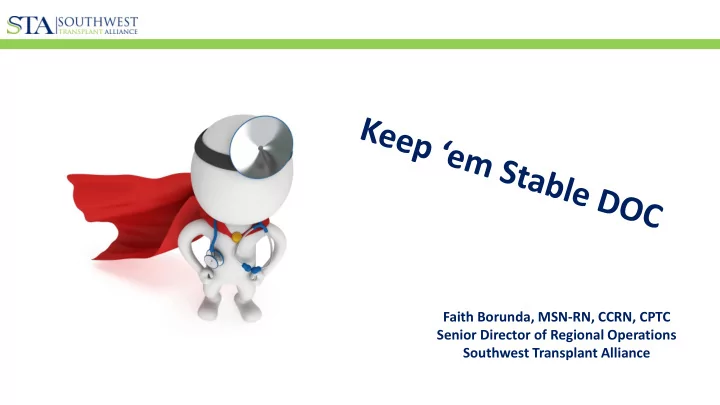

Faith Borunda, MSN-RN, CCRN, CPTC Senior Director of Regional Operations Southwest Transplant Alliance
The Never-Ending Need 114,401 in the U.S. wait for a lifesaving transplant… * United Network for Organ Sharing (UNOS)
The Never-Ending Need 11,840 Texans need a lifesaving transplant… * United Network for Organ Sharing (UNOS)
The Never-Ending Need Another person is added to the transplant wait list * United Network for Organ Sharing (UNOS)
The Never-Ending Need 22 people die everyday waiting for the organ that * United Network for Organ Sharing (UNOS) never comes
Problem Statement --Transplantation has become the standard treatment for many patients with organ failure, however, lack of viable organs for transplantation in the United States results in an increased number of deaths among potential donor recipients each year (UNOS, 2017). * United Network for Organ Sharing (UNOS)
Pathophysiology of Brain Death
What is pre-donor management? Stabilization of the potential donor to allow for brain death testing or DCD efforts Optimization of the function and viability of all transplantable organs Implementation of a collaborative process between the OPO and hospital staff to increase the chances of life-saving transplantation
Management of a potential donor Stabilize hemodynamics Support homeostasis Optimize donor organ perfusion
How can you optimize the process? Continue to follow your Catastrophic Brain Injury Guidelines (CBIGS) or Traumatic Brain Injury Protocol (TBI) Make sure necessary orders exist and are available for ideal patient care Ex: dopamine and vasopressin Critical Care treatment to support the patient through the brain death process
Autonomic/Sympathetic Storm Catecholamine release Tachycardia Elevated cardiac output Vasoconstriction Hypertension
Results of Hypothalamus failure Impaired temperature regulation leading to most likely hypothermia Leads to vasodilation without the ability to vasoconstrict or shiver (loss of vasomotor tone) Which then leads to problems with the pituitary gland…
Pituitary failure Diabetes insipidus with loss of ADH production Resultant hypovolemia and electrolyte imbalances
Thyroid failure Cardiac instability Hemodynamic instability Coagulopathy
Intensive Care Management Rule of 100s SBP > 100 mm Hg HR < 100 UOP > 100 mL/hr PaO2 > 100 mm Hg Aggressive resuscitative therapy to restore and maintain intravascular volume SBP > 90 mm Hg (MAP > 60 mm Hg) CVP ~ 10 mm Hg
Intensive Care Management Neurogenic pulmonary edema Catecholamine storm Left-sided heart pressures exceed pulmonary pressure Interstitial edema/alveolar hemorrhage
Intensive Care Management Release of tissue plasminogen activator Coagulopathy and possibly DIC
Intensive Care Management Hypotension Crystalloids vs. colloids Dopamine/Neosynephrine Vasopressin Thyroxine (T4)
Intensive Care Management T4 protocol Bolus: 2 grams Methylprednisone 20 mcg T 4 (Levothyroxine) IVP 20 units of Regular Insulin 1 amp D 50 W Infusion: 400 mcg T 4 in 500 cc NS Run at 25 cc/hr (20 mcg/hr) Titrate to keep SBP >100 Monitor Potassium levels closely!
Intensive Care Management Vasopressin Protocol May initiate with a 4 Unit Bolus 1-4 Units/hour – titrate to keep SBP >100 or MAP >60 Replace Urine 1:1 for Diabetes Insipidus Inotropic Preference Dopamine and Neosynephrine
Intensive Care Management Impaired gas exchange Maintain PaO2 >100 and an oxygen saturation >95% PEEP 5cm, increase PRN HOB >30 degrees Increase ET cuff pressure Aggressive pulmonary toilet Avoid over-hydration Lung protective strategies Avoid oxygen toxicity CT and bronchoscopy sometimes necessary
Intensive Care Management Electrolyte management Hypokalemia Hypernatremia Hypocalcemia Hypomagnesemia Hypophosphatemia
Intensive Care Management Hypothermia Continuous temperature monitoring and correction
Intensive Care Management Anemia Prefer an H/H >10 & 30% Transfuse and reassess Identify source of blood loss and treat
The Heart of A Champion Stabilization is Key to saving Lives Normal Fluid Balance and Electrolytes to facilitate Brain Death Testing Pronouncement of Brian Death removes the burden from the family Organ Donation helps families through their grieving process
The Heart of A Champion STA’s Common Goal is to Save Lives! Let’s work together, as a TEAM to maximize the viability of donor organs for transplant
References • Determining Optimal Threshold for Glucose Control in Organ Donors after Neurologic Determination of Death: A United Network for Organ Sharing Region 5 Donor Management Goals Workgroup Prospective Analysis – Article – Sally MB, Ewing T, Crutchfield M, et al. (2014), J Trauma Acute Care Surg, 76(1): 62-68, 69. doi: 10.1097/TA.0b013e3182ab0d9b. • ICU Management of the Potential Organ Donor: State of the Art – Article (subscription) – Maciel, C. and Greer, D. (2016). Current Neurology and Neuroscience Reports , 16(9). https://doi.org/10.1007/s11910-016-0682-1 • Management of the Heartbeating Brain-Dead Organ Donor – Article – McKeown, D., Bonser, R. and Kellum, J. (2012). British Journal of Anaesthesia , 108, pp.i96-i107. https://doi.org/10.1093/bja/aer351 • Management of the Potential Organ Donor in the ICU: Society of Critical Care Medicine / American College of Chest Physicians / Association of Organ Procurement Organizations Consensus Statement – Article – Kotloff RM, Blosser S, Fulda GJ, et al. (2015), Crit Care Med, 43(6): 1291-1325. doi: 10.1097/CCM.0000000000000958. • Organ Donation in Adults: A Critical Care Perspective – Article (subscription) – Citerio, G., Cypel, M., Dobb, G., Dominguez-Gil, B., Frontera, J., Greer, D., Manara, A., Shemie, S., Smith, M., Valenza, F. and Wijdicks, E. (2016). Intensive Care Medicine , 42(3), pp.305-315. https://doi.org/10.1007/s00134-015-4191-5 • The Impact of Meeting Donor Management Goals on the Development of Delayed Graft Function in Kidney Transplant Recipients – Article – Malinoski DJ, Patel MS, Ahmed O, et al. (2013), Am J Transplant, 13(4): 993-1000. doi: 10.1111/ajt.12090. Epub 2013 Feb 13.
Questions?
Recommend
More recommend